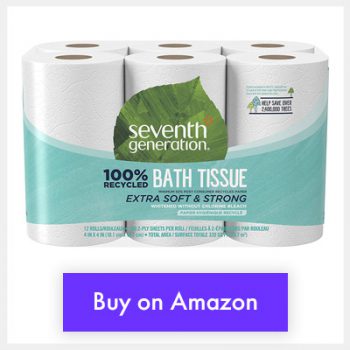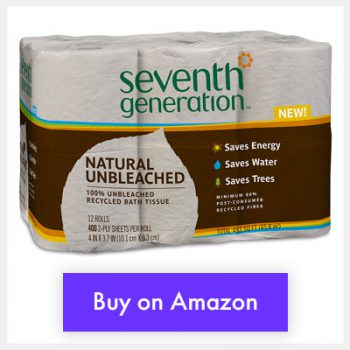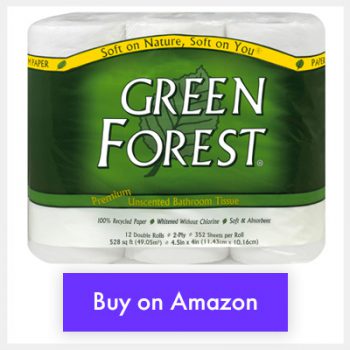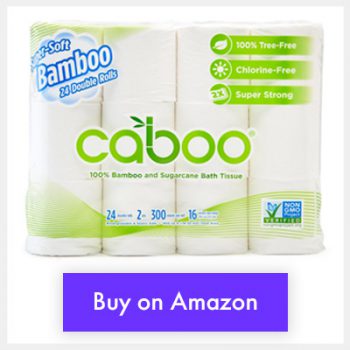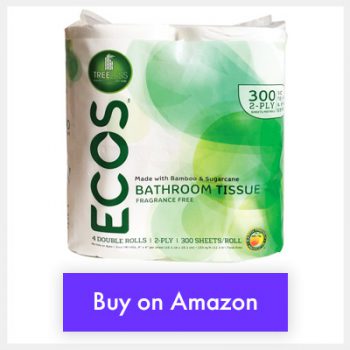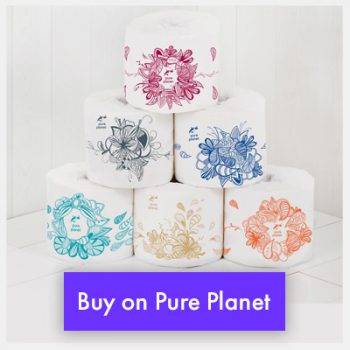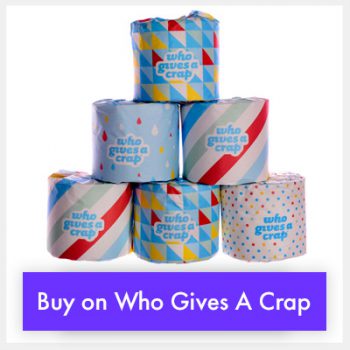Table of Contents
I know how extremely difficult it is to be meticulous, analytical and patient while analyzing and ruling out possible pain factors when you’re experiencing agonizing pain.
Vulvodynia can have a multitude of different causes. And toilet paper, which btw you use every single day on your v (!!), might be one of them.
In my case, the toilet paper that I used gave me a raw, dry and kind of pulling feeling on my v.
In the beginning, it didn’t even cross my mind that it might be one of the culprits of my pain. Then during the process of excluding possible causes, I decided to change the type and brand of toilet paper, and guess what! My dry, raw and pulling feeling that usually decreased during the days, reaching its apex before going to bed – disappeared!
So, if you suffer from vulvodynia and you still haven’t spotted the culprits of your pain, toilet paper is a good place to start (or continue) your research.
#1: Fragrances / Parfum
If your toilet paper has a flowery, perfumed or chemical smell – stay away from it. At first glance, it might look harmless, but I can assure you – it is not.
The Toxic Truth
The “fragrances” and “parfum” are blank terms under which companies are allowed to list a bunch of chemicals and compounds.
Each “fragrance” can be made up of dozens or even hundreds of different chemicals. They can be allergens like geraniol or eugenol, hormones and reproductive system disruptors like phthalates, or cancer-causing chemicals like styrene.
Companies don’t have to disclose the individual chemicals used. As of today, there are 3999 ingredients that can hide behind the word “fragrance.”
Chemicals in Your Body
The chemicals can simply seep into your body through the pores in your biggest organ, your skin, and enter your bloodstream.
The sad truth is that you can never truly know what mix of allergens or toxic chemicals is used for any particular fragrance products that you use and how this can affect your body, your vagina, and your vulva.
Fragrances and Vulvodynia
(And Other Vulvovaginal Conditions)
Solutions
If you suspect that fragrances might be a culprit of your vulvodynia or worsen your pain:
- Go for unscented toilet papers, without even a slightly flowery, perfumed or chemical smell
- When at the shop, look for any information on the packaging indicating that the product is unscented
- Sniff the package. Usually, fragrances are pretty strong so you can smell them even when the package is sealed
- Check the producer’s website if you have any doubts
Our Toilet Paper Recommendations
#2: Mineral Oils
If your toilet paper is scented or infused with any types of lotions, like aloe vera, that might again be problematic.
Disgusting Reality
Many synthetic chemicals in fragrances are often derived from mineral oils and in lotions, they have long been used as the most common ingredient. Mineral oils, also called “liquid petroleum,” “paraffin oil,” and “white mineral oil”, are a liquid by-product of refining crude oil to make gasoline and other petroleum products!
A 2011 study reported that mineral oil hydrocarbons are one of the greatest contaminants of the human body. They accumulate in your tissues and eventually, these stored toxins may lead to health issues.
Additionally, an Environmental Working Group (EWG) analysis showed that 80% of petroleum-based beauty products may be contaminated with impurities that are linked to cancer and other health concerns.
Mineral Oils and Vulvodynia
(And Other Vulvovaginal Conditions)
Solutions
If you suspect that mineral oils might be a cause of your vulvodynia or aggravate your pain:
- Go for unscented toilet papers, without any additional lotions or softeners
- When at the shop, look for any information on the packaging indicating that the product is unscented and doesn’t contain lotions
- Sniff the package. Usually, fragrances and lotions are pretty strong so you can smell them even when the package is sealed
- Check the producer’s website if you have any doubts
#3: Bleaching Agents
To deliver a perfectly white paper to your hands, the pulp and paper industry bleaches it.
Apart from whitening purposes, the bleaching process is also used to separate wood fiber from lignin, the “glue” that holds a tree together. Thanks to this, the final product is white, soft, strong, and sustainable with extended shelf-life.
Danger of Bleaching
And yes, while the new form of bleaching may indeed sound like a healthier and safer alternative, unfortunately, it still employs chlorine-based chemicals like toxic chlorine dioxide.
Chlorine dioxide reacts with organic molecules in the wood and other fibers and creates many poisonous byproducts including dioxins (albeit less than chlorine).
Dioxins - Harmful Byproducts
Dioxins include a range of different substances and are one of the most toxic human-made chemicals. Once released into the environment, they’re persistent because natural bacteria cannot effectively break them down.
They accumulate in the human body and are kept in a consistent level in your blood for years and even decades.
Bleaching Agents And Vulvodynia
(And Other Vulvovaginal Conditions)
Solutions
If you suspect that bleaching agents might be a reason of your vulvodynia or intensify your pain:
- Opt for toilet paper that is bleached without chlorine or go for an unbleached version
- When at the shop, always read labels and look for acronyms on the packaging that will tell you what kind of bleaching process was used on your roll:
- UNBLEACHED – Recycled toilet papers that have NOT been re-bleached. However, recycling paper may contain traces of chlorine substances from its “previous life”
- PROCESSED CHLORINE-FREE (PCF) – A bleaching process which entirely excludes the use of chlorine and chlorine dioxide. However, like mentioned above, recycling paper may contain traces of chlorine substances
- ELEMENTAL CHLORINE-FREE (ECF) – A bleaching process which excludes the use of elemental chlorine. A chlorine dioxide is usually the main bleaching agent.
- TOTALLY CHLORINE-FREE (TCF) – A bleaching process which is carried out without any chemicals containing chlorine. Hydrogen peroxide together with ozone or peracetic acid are the most commonly used chemicals. Only virgin paper (not recycled) can be truly chlorine free.
- Check the producer’s website if you have any doubts
NOTE: Please remember that even if you’re purchasing an organic product with “dioxin-free” on the packaging or marketing materials, this product may still contain traces of this harmful toxin.
#4: Bisphenol A (BPA)
From an environmental perspective, recycled toilet papers are obviously the way to go. From a health standpoint, they might not be such a good choice after all, as they are often contaminated with Bisphenol A (BPA).
Recycled Paper and BPA
The largest source of BPA in your eco-friendly recycled toilet paper derives from receipts printed on thermal paper, which is coated in dye and a developer like BPA. This includes lottery tickets, luggage tags, shipping labels, shop receipts, and newspaper ink, to name a few.
However, according to Seventh Generation’s website, the BPA issue might not be solely the problem of advertised recycled papers anymore! The company claims that “although it frequently goes unadvertised, there are almost no brands (of toilet papers) being made today without recycled fibers.” Additionally, “some tests have shown that even some virgin toilet paper products have detectable levels of BPA.”
BPA is linked to heart disease, diabetes, fetal brain development, breast cancer and asthma.
BPA And Vulvodynia
(And Other Vulvovaginal Conditions)
Solutions
The good news is that the concentration of BPA in your toilet paper is very small (around a microgram per gram) so the exposure risk is tiny.
However, if you suspect that BPA might be a culprit of your vulvodynia or worsen your pain:
- Opt for bamboo toilet paper to be sure to exclude BPA entirely from your paper products
- When at the shop, look for “BPA-Free” symbols on packaging
- Check the producer’s website if you have any doubts
#5: Colorants / Dyes
Colored toilet paper can come in various options from lilac, pink to yellow or even black. It is harder to find them now as they are not a paper delicacy anymore, like in the ’70s. However, if you ever come across them, please don’t purchase them.
Colored toilet paper may add color to your bathroom but they can be harmful to your body.
Colorants/Dyes And Vulvodynia
(And Other Vulvovaginal Conditions)
Solutions
If you suspect that colorants and dyes might be causes of your vulvodynia or worsen your pain:
- Opt for unbleached (brown or grey) or bleached without chlorine toilet papers
#6: Formaldehyde
When you see strong, heavy looking and fluffy toilet paper, you are most likely looking at a product that contains formaldehyde.
Formaldehyde is used to improve toilet paper’s resistance to wetness.
This chemical is linked cancer and serious body irritations.
Formaldehyde And Vulvodynia
(And Other Vulvovaginal Conditions)
Solutions
If you suspect that formaldehyde might be a reason of your vulvodynia or exacerbate your pain:
- Opt for weaker and rougher looking toilet paper
- When at the shop, look for “formaldehyde-free” symbols/information on packaging
- Check the producer’s website if you have any doubts
#7: Mercury and Nickel
Bleached toilet paper can be contaminated with mercury. Mercury might get into products through the manufacturing process where particular goods use mercury, and trace amounts remain in the finished products.
Additionally, recycled toilet paper might be contaminated with nickel.
Mercury, Nickel, and Vulvodynia
(And Other Vulvovaginal Conditions)
Solutions
If you suspect that formaldehyde might be a reason of your vulvodynia or exacerbate your pain:
- Opt for unbleached bamboo toilet paper
Our Toilet Paper Recommendations
Conclusion
In this post, you can find information about:
- Eight dangerous ingredients that might be lurking in your toilet paper and contribute to your vulvodynia and other vulvovaginal conditions
- How you can spot them in products that you buy
- What alternatives are in the market that you can choose from, such as other toilet papers
Did you find this post helpful? What other types of information would you like me to share with you?
Have you noticed that your pain is caused or worsened by toilet paper that you use? What products do you use and would recommend?
Share with me all of your thoughts, experiences, and questions in the comments below! You can also ask me anything directly on FB.
Disclaimer
My goal is to provide you with the most relevant and current information that is factually correct, comprehensive and up-to-date.
However, the product information provided herein is subject to changes and is not intended to cover all possible:
- Adverse effects and complications
- Possible solutions
Additionally, each person is different and may respond differently to different products.
Please also bear in mind, that this article should not be used as a substitute for the knowledge and expertise of a doctor or other licensed healthcare professionals.
Resources
- https://www.who.int/news-room/fact-sheets/detail/dioxins-and-their-effects-on-human-health
- https://www.medicalnewstoday.com/articles/17685.php
- https://www.ewg.org/research/bpa-in-store-receipts
- https://www.ncbi.nlm.nih.gov/pmc/articles/PMC2860827/
- https://www.ewg.org/enviroblog/2010/02/3163-ingredients-hide-behind-word-fragrance
- https://www.cpsc.gov/PageFiles/169902/CHAP-REPORT-With-Appendices.pdf
- https://en.wikipedia.org/wiki/Endocrine_disruptor#Bisphenol_A_(BPA)
- https://www.ncbi.nlm.nih.gov/pubmed/21605673
- https://www.theguardian.com/lifeandstyle/2015/feb/10/phthalates-plastics-chemicals-research-analysis
- https://www.ncbi.nlm.nih.gov/pubmed/20821602
- https://ir.uiowa.edu/cgi/viewcontent.cgi?article=1255&context=pog
- https://www.princeton.edu/~ota/disk1/1989/8931/893103.PDF
- https://www.bloomberg.com/news/articles/2018-12-20/asian-stocks-face-mixed-start-after-u-s-slide-markets-wrap
- https://www.atsdr.cdc.gov/toxprofiles/tp111-c1.pdf
- https://www.nrcm.org/projects/waters/cleaning-up-the-androscoggin-river/maines-dioxin-problem/
- https://www.afandpa.org/docs/default-source/default-document-library/facts-about-the-use-of-bleaching-agents-final.pdf?sfvrsn=2
- https://www.womenshealthspecialists.org/health-information/urinary-tract-infections/
- http://blog.toiletpaperworld.com/where-did-all-the-colored-toilet-paper-go/
- https://www.northeastern.edu/ehs/wp-content/uploads/2016/08/Bleach-Mercury-Fact-Sheet-Final.pdf
- https://www.ewg.org/node/15111/print
- https://en.wikipedia.org/wiki/Mineral_oil
- https://www.huffpost.com/entry/secret-scents-the-hidden_b_2907073
- https://www.wellandgood.com/good-looks/ingredient-intelligence-what-you-need-to-know-about-fragrance-in-skin-care/
- https://theskincareedit.com/2014/10/16/petroleum-mineral-oil-skin-products
- https://www.prevention.com/health/a20506336/4-hidden-dangers-lurking-in-your-toilet-paper/
- https://www.huffingtonpost.com/jennifer-grayson/eco-etiquette-is-my-toile_b_1008317.html
- https://www.care2.com/greenliving/is-tp-ruining-the-health-of-your-vagina.html
- https://www.huffpost.com/entry/recycled-toilet-paper_b_2822188
- https://www.healthline.com/health/high-estrogen
START YOUR JOURNEY TOWARDS HEALING
Because life’s too short. And you deserve to be healthy + happy.


